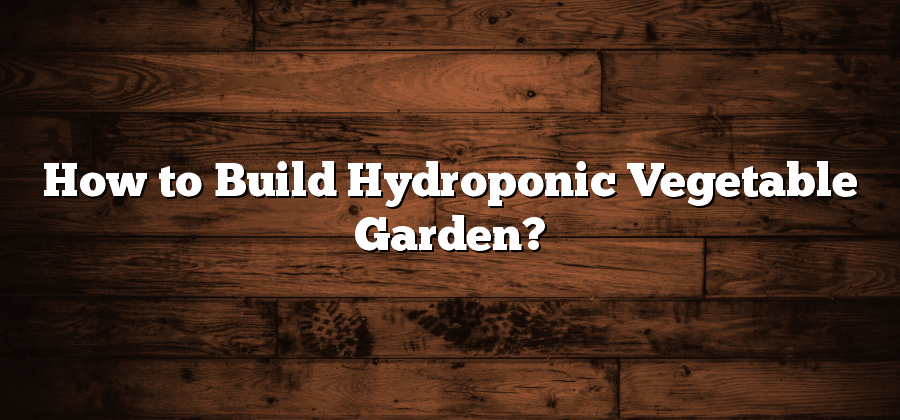Selecting the Ideal Location
When it comes to setting up a hydroponic system, choosing the ideal location is a crucial first step. The success of your hydroponic project depends largely on the environmental conditions that the plants will be exposed to. Look for a location that receives ample sunlight, preferably in a spot that gets at least 6-8 hours of direct sunlight each day. Keep in mind that some plants may require more or less sunlight, so research the specific light requirements of the vegetables you plan to grow. Additionally, the location should be easily accessible and have a stable source of electricity, as hydroponic systems rely on artificial lighting and nutrient pumps.
Another important factor to consider when selecting an ideal location is the availability of space. Hydroponic systems can vary in size, from small setups suitable for home gardens to large-scale commercial operations. Assess the space you have available and choose a location that can accommodate the size of the system you plan to install. Consider both the horizontal and vertical space requirements, as some systems may require height clearance for vertical growth. It is also important to ensure that the location has proper ventilation and air circulation to prevent the buildup of excess humidity and the growth of pests or diseases.
Choosing the Right Hydroponic System
When it comes to selecting the ideal hydroponic system for your gardening needs, there are a few key factors to consider. First and foremost, you’ll want to think about the specific goals you have for your hydroponic garden. Are you looking to maximize space efficiency? Or perhaps you’re more interested in ease of maintenance? Understanding your objectives will help guide you towards the right system.
Secondly, take into account the available resources you have, such as time, space, and budget. Some hydroponic systems require more space and investment upfront, while others can be compact and cost-effective. It’s crucial to choose a system that aligns with your available resources to ensure a successful and sustainable venture.
Remember, selecting the right hydroponic system is not a one-size-fits-all approach. It’s essential to do thorough research, seek professional guidance if needed, and evaluate your specific requirements to make an informed decision that will set you up for hydroponic gardening success.
Determining the Suitable Vegetables to Grow
When it comes to determining the suitable vegetables to grow in your hydroponic system, several factors should be taken into consideration. One of the key factors is the climate and growing conditions in your area. Certain vegetables thrive better in specific climates, so it is important to choose varieties that are well-suited to the local weather patterns and temperatures. Additionally, think about the seasonality of the vegetables you are considering. Some vegetables, such as tomatoes and bell peppers, may grow well in the warmer months, while leafy greens like lettuce and spinach can tolerate cooler temperatures and are great options for year-round cultivation.
Another aspect to consider when selecting the ideal vegetables for your hydroponic system is your personal preferences and goals. Think about what vegetables you and your family enjoy eating the most. Growing vegetables that you and your loved ones are fond of not only ensures that you will have a delicious harvest, but it also increases motivation and satisfaction in the process of hydroponic gardening. Additionally, consider your goals for growing vegetables. Are you looking to create a sustainable food source, save money on groceries, or simply enjoy the therapeutic benefits of gardening? Defining your objectives will help in narrowing down the options and choosing the vegetables that align with your aspirations.
Procuring High-Quality Seeds or Seedlings
When it comes to hydroponic gardening, selecting high-quality seeds or seedlings is crucial for the success of your crop. The first step in procuring these essential ingredients is to do thorough research. Look for reputable suppliers or nurseries that specialize in hydroponic gardening. Check their reviews and ratings to ensure they have a track record of providing top-notch seeds or healthy seedlings.
Once you have identified potential suppliers, it’s important to examine their offerings closely. Look for seeds or seedlings that are labeled as disease-resistant and high-yielding. This will help ensure that your plants have a better chance of thriving in the hydroponic system. Additionally, consider organic options if you want to grow pesticide-free produce. Make sure to inquire about the germination rate of the seeds and the overall health of the seedlings. Taking the time to procure high-quality seeds or seedlings will set you up for success in your hydroponic garden.
Preparing the Growing Medium
To ensure successful hydroponic cultivation, proper preparation of the growing medium is essential. The growing medium serves as a substitute for soil, providing support and anchorage to the plants’ roots. It also holds water and nutrients necessary for healthy plant growth. When preparing the growing medium, it is crucial to choose a material that is lightweight, well-draining, and sterile. These characteristics help prevent waterlogging, nutrient deficiencies, and the growth of harmful pathogens.
One popular choice for hydroponic systems is coconut coir, a sustainable and environmentally friendly material. Coconut coir has excellent water retention properties while also allowing for proper aeration. Another commonly used medium is perlite, which is made from volcanic rock. Perlite is lightweight and porous, providing good drainage and oxygenation for the roots. Both coconut coir and perlite are readily available and can be easily incorporated into different hydroponic setups. Before using these mediums, it is advisable to rinse them thoroughly to remove any dust and excess salts that may interfere with plant growth.






